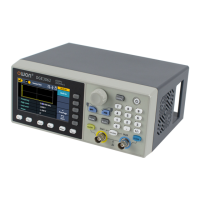Press to set the carrier wave shap.
(2) Press the Mode function key, press the NextPage softkey,then press the
PWM softkey to enter PWM user interface.
Note: If Pulse wave has not been selected, PWM in the menu is
unavailable.
(3) Set carrier wave parameters:
Press to display the waveform and parameters of the carrier wave.
You can change the parameters of the carrier wave. Press Mode to return
to the modulation mode interface.
(4) Select modulating wave source:
Press the Source softkey to select the modulating wave source.
If you select External, use the Sync/Ext Mod/Trig/FSK connector at the
rear panel to input the external modulating signal, then skip ahead to step
(7).
If you select Internal, continue with the following steps.
(5) Select modulating wave shape:
Press the Shape softkey, then press the Sine, Square, Ramp or Noise
softkey to select the modulating wave.
(6) Set modulating wave frequency:
Press the PWM Frequency softkey to set the modulating wave frequency.
The range is 2 mHz – 1 MHz (for internal source only).
(7) Set duty cycle deviation:
Duty cycle deviation is the deviation (in %) of the modulating wave duty
cycle relative to the original pulse duty cycle. Press the Deviation softkey
to set the PWM duty cycle deviation.
Duty cycle deviation range: 0% ≤ deviation ≤ upper limit (upper limit is
carrier duty cycle or 100% minus carrier duty cycle, the smaller of the
two).
ASK (Amplitude Shift Keying)
Amplitude Shift Keying modulation is a modulation technique that shifts the
output signal amplitude between two amplitudes: the carrier amplitude and
modulating amplitude. Carrier wave amplitude shifts to the modulating
amplitude with the specified ASK rate, and then returns to the original
amplitude. The ASK user interface is shown below.

